The Legend of Zelda: Skyward Sword Review
 Game: The Legend of Zelda: Skyward Sword
Game: The Legend of Zelda: Skyward Sword
Developer: Nintendo
Publisher: Nintendo
Available on: Nintendo Wii only
25 years is a hell of a long time. A hell of a lot has happened to me in the last quarter of a century, which I won’t go into here, being a family games website. But needless to say, my oft-checkered existence has been enriched greatly by a constant presence in my life. You see, from the age of six or seven, Nintendo, under the watchful gaze of Miyamoto-san, have been employing their magical game craftsmanship to create the Legend of Zelda series for me. Games that would be my companions, games I could always rely upon, games that no matter what was going on in my own little world, would transport me to Hyrule and allow me to live vicariously through Link’s many exceptional adventures. The announcement of a new Zelda game is a big deal, something that is guaranteed to make me more excited than any other videogame related announcement. Because for 25 years, Nintendo have carved out a legacy, a series of games for which expectations are always raised to massive levels. And rightfully so. They very rarely disappoint.
It has been five years since the last time I was able to slip into a virtual green tunic and save the titular princess of the series, if you discount the recent 3DS remake, which served as a stellar stopgap. Released upon the launch of the Wii, Twilight Princess was undoubtedly a superb game, but had its flaws. Firstly, it was in my opinion much better suited to its original platform, the Nintendo Gamecube. The Wii version bolted on some motion sensor controls which were fun for the time but obviously limited in scope to crude swinging for sword attacks and lightgun-esque shooting. The pacing was also slightly odd, with the wolf transformation sequences somewhat jarring against the rest of the game. With a more serious tone and art style and a lengthy quest inspired by Ocarina of Time, Twilight Princess remained until now the only non-Virtual Console airing for Link on the Wii, if you discount the Crossbow Training diversion. This was strange, given that in the intervening period, Nintendo had produced multiple Wii outings for their other big hitters like Mario and Samus.
It turns out that under the guidance of Eiji Aonuma, Nintendo had actually been planning a new Zelda adventure, this time engineered specifically for the Wii, since 2008. The Wii is on its last legs as games consoles go. The Wii U is just around the corner, and promises to take the motion sensors and myriad innovative touches that we have come to expect from Nintendo and drag them kicking and screaming into the HD age. The Legend of Zelda: Skyward Sword is perfectly placed to be the swansong for a console that has been something of a disappointment in terms of AAA titles and mark the 25th Anniversary of The Legend of Zelda with something really special. Does it achieve this aim and provide the Wii with a true classic?
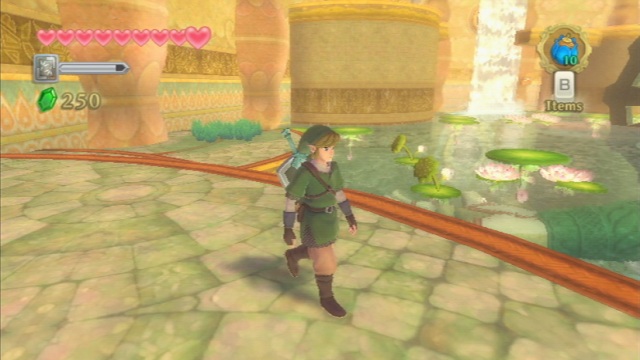
STORY: Skyward Sword serves as a prequel to Ocarina of Time, placing us in control of a teenage Link, who is training to become a knight at a military academy in his home town of Skyloft. As its name suggests, his homestead is a series of floating archipelago above the clouds, where each inhabitant has a symbiotic relationship with their own personal Loftwing, a magnificent giant bird that can be harnessed and ridden through the sky. We catch up with Link as he is about to enter a Loftwing race, a challenge he has to rise to in order to progress with his training and receive a special prize from Headmaster’s daughter Zelda, here cast as a civilian and childhood friend living alongside Link.
After the race, Zelda is whisked away to the unknown terrain below the clouds, known only as “the Surface” by a mysterious, malevolent force. Link is once again tasked with rescuing her and after getting his hands on a new sword, which doubles up as a spirit guide known as Fi, Link whistles for his crimson Loftwing and descends beneath the clouds to the unknown realm, to rescue the girl we are to be believed is his sweetheart.
The story progresses in superlative fashion and whilst I am not about to ruin anything for you, the characters, magnificent cutscenes and exceptional script are such that this is arguably the best and most cinematic Zelda yet.
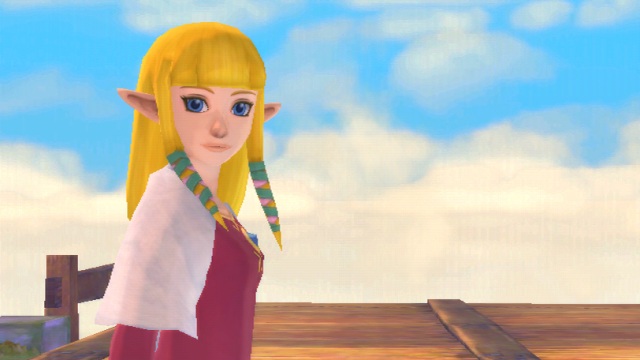
GRAPHICS: With an art style that falls perfectly between the bright, bold, cel-shaded cartoon that was Wind Waker and the grainy moodiness of Twilight Princess, Skyward Sword is by a country mile the nicest looking Zelda adventure to date. The Wii is really being pushed to the limit here and while the graphics cannot hope to come technically anywhere near the likes of the Xbox 360 or PlayStation 3, it is the style in which they are rendered that makes this so mightily impressive.
The huge trees and swathes of forest you encounter early on are reminiscent of the brush strokes of a painting and even evoke the beautiful landscapes of a Studio Ghibli anime. The leafy creatures present in Wind Waker were an obvious nod to Hayao Miyazaki and his influence can be seen here, with a horrific black tentacled monster seen during the intro instantly reminiscent of Princess Mononoke. The visuals are warm and colourful, the characters rendered with true panache with some wildly inventive beasts and townsfolk to encounter. Some of the later environments need to be seen to be believed, with some spectacular dungeons and stunning locations.
SOUND: Musical motifs return from previous games, such as the tune that plays when you enter a house in the village and these are instantly recognisable. But genius composer Koji Kondo has also created a stunning raft of new tunes that suit the action perfectly. There is still no voice acting, however this is no bad thing – part of the charm of the series has always been the fact that you never get to hear Link speak. Would you really want to?
Your companion Fi does speak – albeit in a babbling made-up language, much like Midna in Twilight Princess. There are sound effects that accompany all of the peripheral characters and some of them are very amusing indeed. I found myself in fits of laughter during my first encounter with old favourite Beedle, whose “Oh!” exclamations are hilariously OTT.
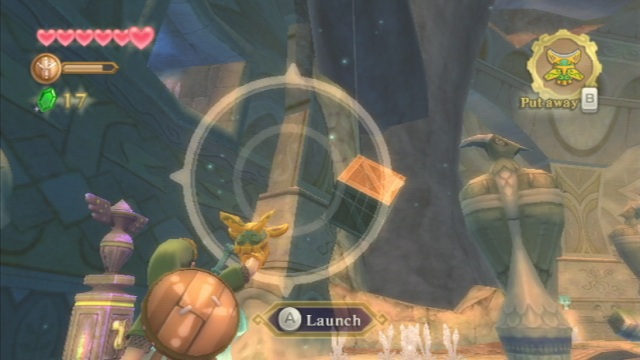
GAMEPLAY: The Nintendo DS Zelda adventures marked the last time that there was a sizeable shift in the way you approach controlling Link. Until now. The MotionPlus controls are implemented brilliantly here, meaning that whilst essentially you are playing through a traditional Zelda game in terms of exploration, item collecting and dungeons, the way you do it is a breath of fresh air and means that you will never want to play at being Link any other way.
Where in its predecessor, the motion controls were crude and inaccurate, here, you actually feel like you are wielding a sword. Enemies can no longer be dispatched by hammering a button or randomly flicking your wrist and require specific directional slashes to off them. A great early example – and one which was used by Nintendo to show off the game at an event I attended early on in the year – are carnivourous plants whose mouths open either vertically or horizontally, requiring a corresponding sword strike to cut them in half. Swordplay is so subtle that it recognises your sideswipes, overhead swings, lunges and even holding your blade aloft to pull of the immensely satisfying Skyward Strike.
You can now use the remote to “dowse” – a technique new to the game which switches the view to first person perspective and allows you to detect and plot your way forward. The bow and arrow, once you get it, is immense fun to use, with a pull on the nunchuck simulating the drawstring. There are a number of other items you can get your hands on and all are brilliant fun to control, particularly a natty flying scarab beetle, that can be piloted via remote control and is used to reach far flung items and even cut down items suspended by ropes with its pincers.
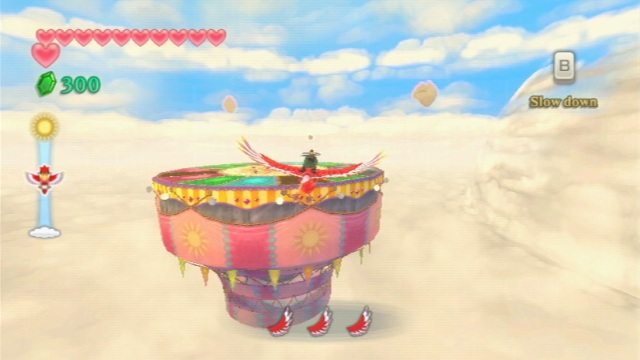
Link is far more agile than ever before. You can run, jump, hang from ledges and even walk tightropes using the motion sensor to balance. You are limited by a stamina bar which will deplete depending on your physical activity, however there are collectable fruit dotted around the landscape that top your meter back up.
Rather than pausing the game to access your arsenal of gadgets and items, here a simple pull of the B button brings up a handy wagon wheel and your item is easily selected by pointing at it. Link also has a fully customisable adventure pouch in which you can to all intents and purposes give him a loadout of equipment to take with him into battle. You can use the pouch to store additional bombs and arrows, or even special medals which increase the number of hearts you have. It is a welcome new system that makes you weigh up each situation and decide which tactic is best to employ – fully loaded with ammo, or erring towards the defensive?
New to the series is the ability to level up your equipment using objects that you find along the way – such as strengthening your shield and armor. In another first for Zelda, your shield only has a limited amount of resistance and will need to be repaired or replaced once it takes enough damage to wipe out its energy bar. Returning to Skyloft to visit the blacksmith can rectify this; give him the right combination of items and he can tinker with it and make it more sturdy.
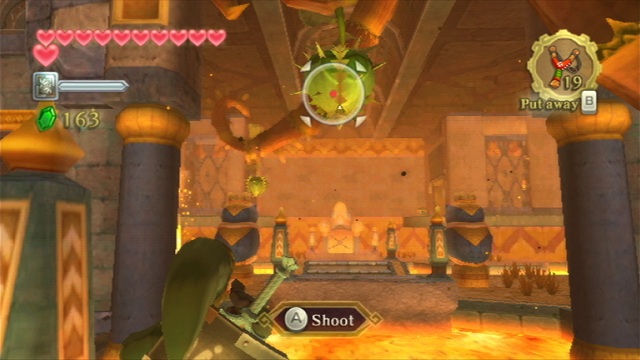
The quest follows a familiar pattern – you gather information and required items and work your way toward each dungeon area – yet Nintendo have crafted the game so that it feels fresh and a real revolution for the series. The interface between the Sky and the Surface is brilliantly done. The boats and trains of previous games are replaced by the Loftwing, which is elegantly controlled using the motion sensor and provides an exhilarating way of getting around. You can fly to gaps in the clouds and descend to the surface below before leaping off into the air and using a parachute-like Sailcloth – bestowed upon you by the lovely Zelda after you win the initial Loftwing derby – to float safely to the ground. There are also generous amounts of save points that also allow you to teleport instantly between Skyloft and the Surface. A genius inclusion is the ability to place beacons onto your map, which create a giant pillar of light to indicate your desired destination. You can employ beacons whether you are flying on your Loftwing or on foot, which makes navigation far easier. Those of you who can recall the hours of cumbersome sailing in Wind Waker will love this addition. The maps are also incredibly detailed and instantly accessible, which helps immensely.
The Shiekah Stones from the recent Ocarina of Time remake return if you are in need of a hint, however it is more likely that your in-game advice will come from Fi, as worthy a companion as Link has ever taken with him on a journey. Fi assists in practical ways such as offering guidance and tips and is used as a bestiary – Z-target an enemy and she will provide you with information on the creature and the best way of dealing with it. She is also scripted hilariously – offering you myriad information about the statistical probabilities of this, that, and the other – and as such comes off as an extremely welcome addition as opposed to an annoyance.
There are many more innovations to Skyward Sword, including some surprising mechanical contraptions, time travel elements, mind-blowing dungeons with unexpected conclusions, and much, much more.
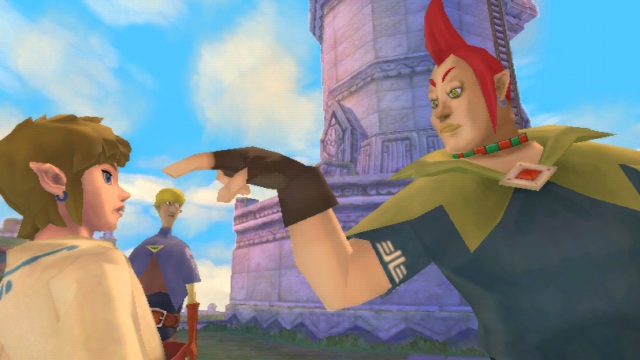
LONGEVITY: There is so much to see and do. I managed to effortlessly put in six hours of gameplay prior to entering the first dungeon – simply carrying out side quests (of which there are many), flying around on the back of my giant crimson pal and hunting down bugs – easily the most enjoyable distraction yet seen in the franchise. Fishing? Pah! The main quest is lengthy but not a chore – it throws up so many surprises and curveballs that you won’t want to stop playing once you have started. There are around 30 hours in the basic game, but add another twenty to that if you want to take on the many extra assignments on offer. Up in Skyloft, there is always someone who needs a task carried out.
VERDICT: Skyward Sword doesn’t just reinvigorate the Zelda series, it proves that with correct game design and implementation, the Wii couple with its Motion Plus controller, can produce results. It is disappointing that it has taken so long for this to be achieved, but that gripe aside – this is the best use of motion controls yet seen in a fully formed adventure videogame, you cannot fail to be impressed with the amazingly accurate swordplay, the subtle ways you can trap an insect in a butterfly net, the elegant way you can soar through the skies.
The game design itself is mind-blowing. The new inclusions feel as natural as breathing. The story is spectacular. Cinematic is an appropriate description – with lashings of romance, a wonderful cast of characters and a truly beautiful world to explore, this is arguably the greatest Zelda adventure yet, transcending even the brilliance of the revered Ocarina of Time. If you own a Wii, then this is the reason it was invented, the game that finally realises the unreal potential of the console. Nintendo are going to have to pull off something approaching a miracle to top this when they bring Link to their next generation console.
A genuine classic.





